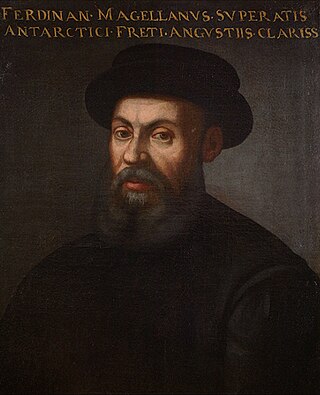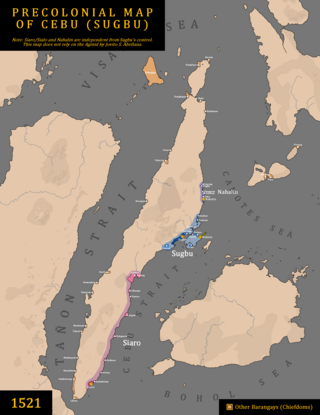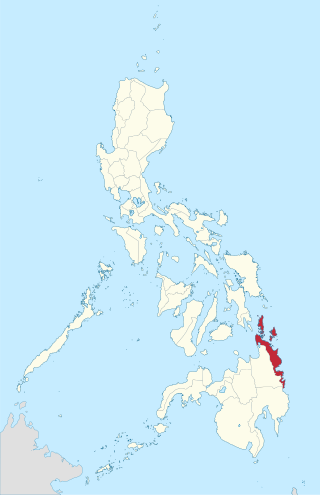
Miguel López de Legazpi, also known as El Adelantado and El Viejo, was a Spanish conquistador who financed and led an expedition to conquer the Philippine islands in the mid-16th century. He was joined by Guido de Lavezares, relative Martin de Goiti, friar Andrés de Urdaneta, and his grandsons Juan and Felipe de Salcedo, in the expedition. Legazpi established the first Spanish settlement in the East Indies after his expedition crossed the Pacific Ocean, arriving in Cebu in 1565. He became the first Governor-General of the Spanish East Indies, which was administered from New Spain for the Spanish crown. It also encompassed other Pacific islands, namely Guam, the Mariana Islands, Palau, and the Carolinas. After obtaining peace with various indigenous tribes and kingdoms, he made Cebu City the capital of the Spanish East Indies in 1565 and later transferred to Manila in 1571. The capital city of the province of Albay bears his name.

The Battle of Mactan was fought on a beach in Mactan Island between Spanish forces led by the Portuguese explorer Ferdinand Magellan along with local allies, and Lapulapu, the chieftain of the island, on the early morning hours of April 27, 1521. Magellan, a Portuguese-born commander serving the Spanish Empire who led an expedition that ultimately circumnavigated the world for the first time, commanded a small Spanish contingent in an effort to subdue Mactan led by Lapulapu under the Spanish crown. The sheer number of Lapulapu's forces, compounded with issues on the location and armor, ultimately resulted in a disastrous defeat to the Europeans and the death of Magellan. Surviving members of Magellan's crew continued the expedition under the command of Juan Sebastian de Elcano, who completed the journey in September 1522.

Surigao del Norte, officially the Province of Surigao del Norte, is a province in the Philippines located in the Caraga region of Mindanao. The province was formerly under the jurisdiction of Region 10 until 1995. Its capital is Surigao City. The province comprises two major islands—Siargao and Bucas Grande—in the Philippine Sea, plus a small area at the northeastern tip of mainland Mindanao and other surrounding minor islands and islets. This mainland portion borders Agusan del Norte – between the Municipality of Alegria in Surigao del Norte and the Municipality of Kitcharao in Agusan del Norte; and the province of Surigao del Sur, to the south.

Limasawa, officially the Municipality of Limasawa, is an island municipality in the province of Southern Leyte, Philippines. According to the 2020 census, it has a population of 6,191 people, making it the least populated town in the province.
Datu Sikatuna was a Datu or chieftain of the Bool Kingdom in the island of Bohol in the Philippines. He made a blood compact (sanduguan) and alliance with the Spanish explorer Miguel López de Legazpi on March 25, 1565 at Hinawanan Bay, barangay Hinawanan, Loay. Their blood compact is the first Treaty of Friendship between Spain and the Philippines. The previous site of the pact was thought to have been at barangay Bool, Tagbilaran City but later a panel of historians concluded that the event actually happened at barangay Hinawanan, Loay, Bohol as ratified through Resolution No. 4, issued by the National Historical Institute in 2005.
The Surigaonon people are an ethnolinguistic group who inhabited on the eastern coastal plain of Mindanao, particularly the provinces of Surigao del Norte, Surigao del Sur and Dinagat Islands. They are also present in the provinces of Agusan del Norte, Agusan del Sur, and in Davao Oriental. They are part of the Bisaya people, who constitute the largest Filipino ethnolinguistic group in the country.
Datu Daya was a legendary lord of Kandaya, the place that is now known as Daanbantayan, Cebu, in the Philippines.
Rajah Humabon later baptized as Don Carlos Valderrama, was one of the recorded chiefs in Cebu who encountered Ferdinand Magellan in the 16th century. Humabon ruled at the time of the arrival of Portuguese-born Spanish explorer Ferdinand Magellan in the Philippines in 1521. Humabon, his wife, and his subjects were the first known Christian converts in the Philippines. However, since there were no Catholic priests in Cebu from 1521 to 1565, this Christianity was not practised until the return of the Spaniards to Cebu. There is no official record of Humabon's existence before the Spanish contact. The existing information was written by Magellan's Italian voyage chronicler, Antonio Pigafetta on Humabon and the indigenous Philippine peoples that existed prior to Spanish colonization. Rajah Humabon is cited as the reason for why Magellan fought in the Battle of Mactan, as the latter wanted to earn the trust of Humabon by helping him subdue his opponent Lapulapu, one of the chiefs of Mactan. Despite being referred to as "king" in the journal of Antonio Pigafetta, he was not one like in the manner of a monarch in centralized societies, it is plausible that the title was mistakenly applied because according to succeeding chroniclers, there were no kingdoms in the pre-colonial Philippines.

Ferdinand Magellan was a Portuguese explorer best known for having planned and led the 1519 Spanish expedition to the East Indies across the Pacific Ocean to open a maritime trade route, during which he discovered the interoceanic passage thereafter bearing his name and achieved the first European navigation to Asia via the Pacific. After his death, this expedition was the first to circumnavigate the globe in 1519–22 in the service of Spain.

Butuan, also called the Rajahnate of Butuan and the Kingdom of Butuan, was a precolonial Bisaya polity (lungsod) centered around northeastern Mindanao island in present-day Butuan, Philippines. It was known for its gold mining, gold jewelry and other wares, and its extensive trade network across maritime Southeast Asia and elsewhere. Over its long history the lungsod had direct trading relationships with the ancient civilizations of China, Champa, Đại Việt, Pon-i (Brunei), Srivijaya, Majapahit, Kambuja, and even Persia as well as areas now comprised in Thailand.

The recorded history of the Philippines between 900 and 1565 begins with the creation of the Laguna Copperplate Inscription in 900 and ends with the beginning of Spanish colonization in 1565. The inscription records its date of creation in 822 Saka. The discovery of this document marks the end of the prehistory of the Philippines at 900 AD. During this historical time period, the Philippine archipelago was home to numerous kingdoms and sultanates and was a part of the Indosphere and Sinosphere.
The Treaty of Cebu is a peace treaty signed on June 4, 1565 between Miguel López de Legazpi, representing King Philip II of Spain, and Rajah Tupas of Cebu. The treaty effectively created Spanish suzerainty over Cebu and started the Spanish colonization of the Philippines until 1898.

The Rajahnate of Cebu or Cebu also called as Sugbu, was an Indianized Raja monarchy Mandala (Polity) on the island of Cebu in the Philippines prior to the arrival of the Spanish conquistadors. It is known in ancient Chinese records as the nation of Sokbu (束務). According to Visayan oral legend, it was founded by Sri Lumay or Rajamuda Lumaya, a minor prince of the Tamil Chola dynasty. He was sent by the Chola emperor from southern India to establish a base for expeditionary forces, but he rebelled and established his own independent polity. The capital of the nation was Singhapala (சிங்கப்பூர்) which is Tamil-Sanskrit for "Lion City", the same rootwords with the modern city-state of Singapore.

The Magellan expedition was the first voyage around the world in human history. It was a Spanish expedition that sailed from Seville in 1519 under the initial command of Ferdinand Magellan, a Portuguese sailor, and completed in 1522 by Spanish Basque navigator Juan Sebastián Elcano.

The first documented Catholic Mass in the Philippines was held on March 31, 1521, Easter Sunday. It was conducted by Father Pedro de Valderrama of Ferdinand Magellan's expedition along the shores of what was referred to in the journals of Antonio Pigafetta as "Mazaua".

Malays played a significant role in pre-Hispanic Philippine history. Malay involvement in Philippine history goes back to the Classical Era with the establishment of Rajahnates as well as the Islamic era, in which various sultanates and Islamic states were formed in Mindanao, the Sulu Archipelago, and around Manila.

Surigao was a province of the Philippines. Originally a Spanish-era district, became a chartered province on May 15, 1901. The province was dissolved on 1960.

Singhapala was an ancient fortified city or a region, the capital of the Indianized Rajahnate of Cebu. The location of this ancient city is what is now the modern Barangay Mabolo in the northern district of Cebu City. Founded by Sri Lumay or Raja Muda Lumaya, a half-Tamil prince.











